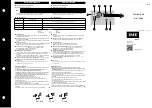
Woodward
Manual MRM3-2 GB
22
TD_MRM3-2_09.08_GB_Rev.New
5.3.6 Parameter Set Changeover Switch (P2)
By means of this switch two different parameter sets can be activated. The changeover procedure
can be realized either by the software or via the digital input (A2). If the parameter set changeover
switch is adjusted to ”SET2“, the active parameter set can be changed to ”SET1“ via the external
input. If the changeover switch is set to ”SET1“, then it can be changed to ”SET2“ via the digital in-
put.
The LED P2 on the front cover always indicates which of the parameter sets is active. Furthermore
it is possible to indicate via an assigned output relay that parameter set 2 is active.
During the setting procedure the LED P2 gives off a yellow light.
5.4 Protection
Parameters
5.4.1 Thermal Overload Protection (k x IB)
With the product of setting values k x IB the continuously permissible maximal current of the motor
is adjusted. At this current the thermal image reaches 100 % after a long period – i.e. the trip thre-
shold.
With IB normally the rated current of the motor is adjusted and with k an overload factor (e.g. 1.05).
It is also possible to adjust the maximal continuous cur-rent directly, if k = 1 was selected.
5.4.2 Warning/Tripping with thermal Overload
Sometimes it is necessary that the thermal protection beyond the 100 % limit does not lead to shut-
down (e.g. fire extinguisher pump). For this reason it is possible to differentiate between tripping
and warning. In case of the warning function the display does not show "TRIP". The relay assigned
to this step responds and should therefore be configured onto a different relay than the one leading
to tripping.
5.4.3 Tripping Delay for Thermal Overload
The starting current of motors is normally many times higher than the rated current. In that case the
threshold for recording the thermal overload k*I
B
> is exceeded. The warning relay responds and
the LEDs signal excitation. Excitation signaling remains active beyond the starting phase as well.
Since starting of the motor is a normal process and not a malfunction, it is possible at this point to
delay detection of the excitation for thermal overload. If the motor is overloaded often and this is
permissible for a short period (e.g. breakers) it may also make sense to operate this overload with
delay action. This delay is also effective in motor OPERATING mode and has no effect on the trip-
ping behavior of the MRM3-2.
Note:
In this case, the signaling of the LED fulfills a special function: The excitation is always indicated
without de-lay. If the excitation limit value is under-run within the delay time, there will be no “flash”
function (see chapter 5.3.5).
5.4.4 Heating Period Constant
τ
W
and Cooling-Down Time Factor
τ
C
With this time constant the thermal image is adapted to the heating behavior of the motor. It is the
time constant of an e-function.
Normally the motor is cooling down with a slower time constant. Parameter
τ
C is to be understood
as a factor. The cooling-down behavior in the thermal model proceeds with the time constant
τ
C x
τ
W
. If
τ
C = 1 is selected, then heating and cooling-down proceed at an identical speed in the thermal
image.
















































